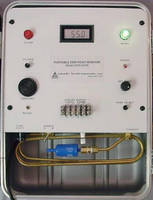Sensors / Detectors / Transducers
Improving the Quality of Plastic Products

Most thermoplastic resins are hygroscopic materials that must be sufficiently dried prior to injection molding. Desiccant dryers and ovens are widely used to dry resins, but how does an operator know that the material is dry enough? The answer: DEW POINT measurement. Without testing, end products are rejected and sent to the scrap heap. To avoid problems such as bubbles, splay, warpage, and voids, the resin must be dried at moisture levels of -40 to -20°F dew point. Measuring the dew point can aid injection molders in reducing scrap rates and increasing profits.
Dew point is defined as the temperature to which air must be cooled to become saturated at a given pressure. When air is saturated it holds the maximum amount of water vapor. Any amount of water vapor that exceeds the "saturation" level turns to liquid (condensation). The dew point temperature of air is directly proportional to mass of water vapor in the air with respect to the ambient pressure.
Desiccant dryers are often used to dry plastic materials. For most desiccant dryers, the design dew point of the air produced is -40°F. It is important to check the performance of these dryers by measuring the dew point of the outlet air. In practice dryers producing air between -40 to -20°F dew point is optimum. As dry air is introduced to plastic resin, water vapor is released, therefore the air leaving the material will increase. When the "return air" dew point reaches a moisture level between -10 to 0°F dew point, most thermoplastics are sufficiently dried. If the return air dew point is higher than 0°F, then material needs to be dried further or spend more time in the dryer.
Ohmic's AMM-15 handheld & DPM-35XR portable units monitor plastics dryers and compressed air. Samples up to 550°F, with a direct readout of dew point.
OHMIC Instruments manufactures a line of dew point measurement instruments. Visit our website, www.ohmicinstruments.com to see our entire line of products.




